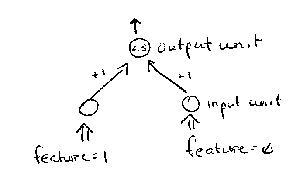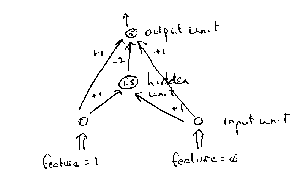1. LOCAL VERSUS DISTRIBUTED REPRESENTATIONS
-IN A CONNECTIONIST MODEL THE RELEVANT IS NOT REPRESENTED LOCALLY,
SUCH AS "NODES" THAT RESEMBLE "CONCEPTS" (IN A CONNECTIONIST MODEL THERE
IS NO NODE FOR A CONCEPT SUCH AS RIPPlE, PRIEST, PARK ETC)
RATHER INFORMATION IS DISTRIBUTED OVER A NUMBER OF PROCESSING UNITS,
NONE OF WHICH STAND FOR A CONCET
2. IN A CONNECTIONIST MODEL, INFORMATION IS CONTAINED IN THE WEIGHTS
BETWEEN PROCESSING UNITS; INFORMATION DEPENDS ON A PAHERN OF ACTIVATION;
THE SAME UNITS
MIGHT BE INVOLVED IN QUITE DIFFERENT INFORMATION
3. CONNECTIONIST MODELS LEARN VIA EXPERIENCE.. .AND DO SO BY CHANGING
THE WEIGHTS BETWEEN UNITS

SO: in example above, output unit will fire if either features is present (feature designated here as either "1" or "0")
System LEARNS; if it responds that a pattern is present when in fact it isn't, then a reduction is made in the strengths of connections from all units that are currently active
-if it fails to recognize a presented pattern, connection strengths are increased
NOTE: some problems: the model will fire if either feature is present but also if both are present
By 1969, some argued (on mathematical analyses) limitations of the sort
mentioned above were too severe and in principle unsolvable.. .they concluded
that one should build models using physical symbol system architectures
